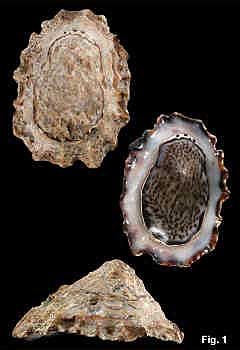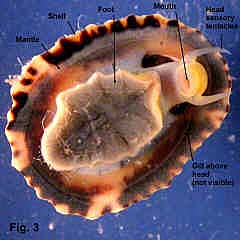|
|
|
|
|
Patelloida latistrigata (Angas, 1865) Description: Shell relatively tall, wider posteriorly; usually eroded. Weakly to strongly sculptured with about 12-30 radial ribs. Exterior colouration dark brown with white ribs where not eroded, grey-brown where eroded. Interior colouration white or grey; margin black or irregularly alternating black and white; spatula white to blue-grey, characteristically spotted with black or brown, outlined with a black or white line. Spotted pattern often evident on exterior of eroded specimens. Size: Up to 26 mm in length, commonly 10-15 mm. Distribution: Endemic to Australia: Coolangatta, Queensland, to Eyre Peninsula, SA, including Tasmania. Habitat: On rock surfaces, in the mid and upper littoral, on exposed and moderately sheltered coasts. Abundant in some areas, uncommon north of Newcastle. The life history and ecology of this species has been investigated at Cape Banks in Botany Bay by Creese (1981, 1982). It lives among the barnacle Tesseropora rosea, where it feeds on diatoms and microalgae on the rock surface and on the barnacles themselves. It maintains a home site, either on the rock or on a barnacle, to which it returns after feeding. It lives among the barnacles because, in this situation, its food supply is protected from the large limpet Cellana tramoserica. Cellana out-competes it for food in open spaces, but can`not move or feed among the closely spaced barnacles. Sexes are separate, and eggs and sperm are broadcast into the sea. Creese found that spawning occurred over an extended period from November to May. Larvae are apparently cast up on the shore at random, but only survive in the appropriate habitat. Growth is slow and life is short; it reaches 9 mm at age 1 year, 12 mm at 2 years and 14 mm at 3 years. Most animals that survived predation to reach three years then died of old age. Earlier mortality was primarily caused by the small predatory gastropod Morula marginalba, which eats the limpets, not by drilling a hole in them (which is usual for muricid predators), but by feeding under the edge of the shell (Fairweather & Underwood, 1983). Morula also eats the barnacles on or among which the limpet feeds, resulting in limpet mortality when dead barnacle shells are washed away. Comparison: Fresh, adult shells can be distinguished by being relatively tall for their size, and by the characteristic spotted pattern of the spatula. Synonymy: Acmaea marmorata Tenison-Woods, 1876; Acmaea marmorata var. submarmorata Pilsbry, 1891 Remarks: The number and strength of the axial ribs varies throughout the range. South Australian and Victorian specimens tend to have a few strong ribs, while NSW shells have more numerous and weaker ribs. Fig. 1 Middle Harbour, NSW (C.056430) Fig. 2 a. Port Arthur, Tasmania (C.042094) b. Yorke Peninsula, South Australia (C.004610) Fig. 3 Live animal. Long Reef, Collaroy, NSW (DLB5079)
|


